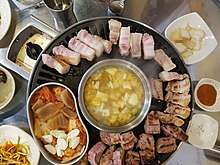Boston butt
Boston butt, or pork butt, is the American name for a cut of pork that comes from the upper part of the shoulder from the front leg and may contain the blade bone.[1] Boston butt is the most common cut used for pulled pork, a staple of barbecue in the southern United States.

In the United Kingdom, Boston butt is known as pork shoulder on the bone, since regular pork shoulder normally has the bone removed and then rolled and tied back into a joint.
History of the name and cut

Some suggest that in pre-revolutionary New England and into the American Revolutionary War, New England butchers tended to take less prized cuts of pork like hams and shoulders and pack them into barrels for storage and transport, known as a butt, which comes from the Latin word "Buttis" meaning cask or barrel. This particular shoulder cut became known around the country as a Boston specialty, and hence it became the "Boston butt".[2] However, the first known reference to the Boston butt as a cut of meat does not appear in print until 1915 in the publication Hotel Monthly.[3] In the UK it is known as "pork hand and spring", or simply "pork hand", or, as noted above, "pork shoulder on the bone".
In Spanish the cut is known as paleta de puerco,[4] and is the main ingredient in the Mexican dish carnitas[5] and in the Caribbean dishes lechon asado[6] and pernil.[7]
In Mexican Spanish, this cut is also known as the espaldilla (literally "little back").
In Argentina, this cut is very popular and is known as bondiola.
In Korea, the cut is known as moksal (목살; literally "neck meat").
References
- "Cuts: Shoulder". TheOtherWhiteMeat.com. National Pork Board. Retrieved 16 October 2009.
- Ethan Trex (July 30, 2009). "How 9 Cuts of Meat Got their names". Mental Floss.
- "Oxford English Dictionary". www.oed.com. Retrieved 2019-11-01.
- Lourdes Castro (10 November 2009). Eat, Drink, Think in Spanish: A Food Lover's English-Spanish/Spanish-English Dictionary. Random House Digital, Inc. p. 259. ISBN 978-1-58008-954-8. Retrieved 28 October 2012.
- "Carnitas". Archived 2011-09-27 at the Wayback Machine Food Resource, Oregon State University. Accessed October 2012.
- Zweiban, Randy. "Mojo Marinated Pork Cubano (Lechon Asado) Recipe". Chowhound. Retrieved 2016-12-08.
- John Giuffo (December 26, 2013). "Pernil, The Puerto Rican Christmas Pork Poast, Is Your New Holiday Favorite". Forbes. Retrieved December 25, 2014.
